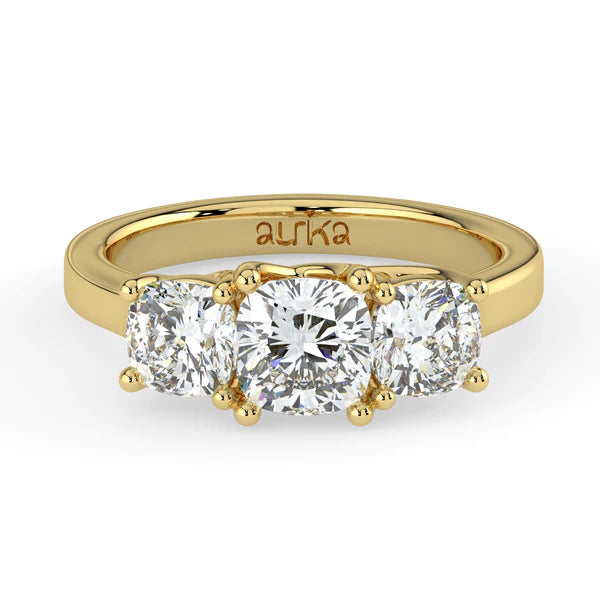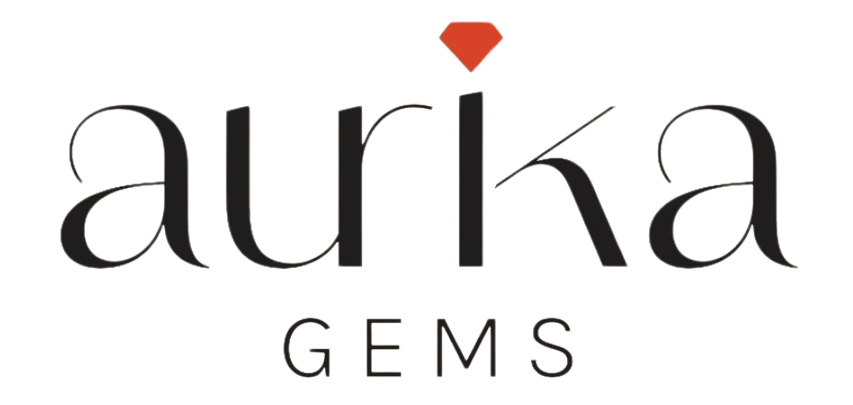
The Ultimate Guide to Three-Stone Engagement Rings
When it comes to engagement rings, one style that has gained immense popularity is the three-stone engagement ring. Known for its timeless beauty and profound symbolism, the three-stone ring is more than just a piece of jewelry—it's a reflection of your love story. Whether you're considering this style for its symbolic meaning, aesthetic appeal, or customization options, understanding the intricacies of the three-stone engagement ring is key to making the perfect choice.
In this guide, we’ll explore everything you need to know about three-stone engagement rings, including their meaning, design options, settings, and how to choose the perfect one. Let's dive into this timeless design and discover why it’s the ideal choice for your special moment.
What is a Three-Stone Engagement Ring?
A three-stone engagement ring (also known as a trilogy or trinity ring) features three prominent stones set in a row. The central stone is usually the largest and most striking, flanked by two smaller stones on either side. Each of these stones holds its own significance, often symbolizing the past, present, and future of a relationship. The center stone represents the present moment, while the two side stones reflect the couple’s past memories and future promises.
Key Characteristics of a Three-Stone Engagement Ring:
- Three stones: One center stone with two complementary side stones.
- Symbolism: Often represents the journey of a relationship—past, present, and future.
- Customizable: Various combinations of diamond shapes, sizes, and gemstones can be used.
The Symbolism of Three-Stone Engagement Rings
The symbolism behind the three-stone design is one of its biggest draws. Traditionally, the stones represent:
- Past: Cherishing the memories and experiences you’ve shared.
- Present: Celebrating your current bond and love.
- Future: Looking forward to a lifetime of togetherness.
This meaning makes the ring perfect for couples who want a deep, emotional connection to their engagement ring, rather than just focusing on aesthetics.
The History of Three-Stone Engagement Rings
The idea of a three-stone ring dates back centuries, but it became a staple in the world of engagement jewelry in the early 20th century. Its rise in popularity is often attributed to its rich symbolism and versatility in design. Celebrities and royal figures have also helped to elevate the appeal of the three-stone ring, making it a trendy yet classic option.
Types of Stones and Shapes for a Three-Stone Engagement Ring
When selecting a three-stone engagement ring, the type of stones and their shapes play a critical role in the overall look. Here’s a breakdown of popular options:
Diamond as the Center Stone
Diamonds are the most popular choice for the center stone due to their brilliance and durability. You can opt for different diamond cuts to achieve distinct looks:
- Round cut: A classic choice that maximizes brilliance.
- Princess cut: A modern, angular shape with a square profile.
- Emerald cut: A rectangular, step-cut shape known for its elegance.
- Oval cut: A softer, elongated shape that creates a unique appeal.
- Cushion cut: A square or rectangular cut with rounded corners for a vintage feel.
Colored Gemstones
For those who want to infuse some color and personality into their ring, colored gemstones like sapphires, rubies, or emeralds are a stunning choice. These stones can be used as either the center stone or the side stones, adding vibrancy to the ring's overall design.
Matching the Side Stones
While the center stone often takes the spotlight, the side stones contribute to the balance and harmony of the design. Side stones can either be smaller diamonds or contrasting gemstones. The side stones should complement the center stone in terms of color, cut, and clarity to maintain the visual appeal.
Popular Settings for Three-Stone Engagement Rings
Prong Setting
The prong setting is the most common and classic option for three-stone engagement rings. Thin metal prongs hold each stone securely, allowing maximum light to enter the diamonds, thus enhancing their sparkle. Prongs are ideal if you want to showcase the individual beauty of each stone without obstruction.
Bezel Setting
The bezel setting features a metal rim that encircles each stone, providing excellent protection. While this setting may reduce some of the sparkle by covering more of the diamond, it offers a sleek, modern look and is perfect for active individuals who prefer durability.
Pavé Setting
A pavé setting features small diamonds encrusted along the band of the ring. This setting enhances the brilliance of the three-stone design and adds a luxurious feel. Pavé settings are great for those who want extra sparkle beyond the three main stones.
Halo Setting
In the halo setting, small diamonds surround the center stone, making it appear larger and more brilliant. This is a popular choice for those looking for a dramatic and dazzling effect. The halo can also be used around the side stones for a more cohesive design.
Metals for Three-Stone Engagement Rings
The choice of metal for your ring band can greatly impact the overall aesthetic. Some of the most popular metals for three-stone engagement rings include:
Platinum
Platinum is a luxurious, durable metal that’s ideal for engagement rings. Its natural white sheen complements diamonds and gemstones beautifully. It’s also hypoallergenic, making it a good choice for those with sensitive skin.
White Gold
White gold has a similar appearance to platinum but is more affordable. It’s created by alloying gold with other metals and often coated with rhodium to give it a lustrous finish. However, white gold may need occasional replating to maintain its shine.
Yellow Gold
For a classic, timeless look, yellow gold is a popular option. Its warm hue pairs well with both diamonds and colored gemstones, giving the ring a vintage or romantic feel.
Rose Gold
Rose gold offers a modern, feminine twist on the traditional engagement ring. The soft pink color is flattering on many skin tones and adds a unique, contemporary flair to the three-stone design.
Customizing Your Three-Stone Engagement Ring
One of the biggest advantages of choosing a three-stone engagement ring is the endless customization options. Here are some ways to personalize your ring:
- Choose different gemstones: You can mix and match diamonds with colored gemstones like sapphires or emeralds for a striking contrast.
- Experiment with shapes: Opt for different cuts for the side stones, such as round center stones with pear-shaped side stones.
- Engraving: Add a personal touch by engraving a meaningful date, initials, or a short message on the inside of the band.
The Importance of the 4Cs When Choosing a Three-Stone Engagement Ring
When selecting the stones for your engagement ring, understanding the 4Cs (cut, color, clarity, and carat weight) is crucial. These factors determine the overall quality and appearance of the diamonds or gemstones.
Cut
The cut of a diamond affects how well it reflects light. A well-cut diamond will sparkle brilliantly, while a poorly cut one may appear dull. Choose stones with an excellent or very good cut for maximum brilliance.
Color
Diamonds are graded on a color scale from D (colorless) to Z (light yellow or brown). For a three-stone ring, it’s important that the side stones match the color of the center stone for a cohesive look.
Clarity
Clarity refers to the presence of inclusions or blemishes in a diamond. Higher clarity grades (FL, IF, VVS) indicate fewer imperfections, though these may be invisible to the naked eye in smaller stones.
Carat Weight
Carat weight measures the size of the diamonds. While larger stones are more expensive, balancing the size of the center and side stones is essential for a harmonious design.
How to Care for a Three-Stone Engagement Ring
A three-stone engagement ring, like any fine jewelry, requires regular care to maintain its brilliance. Here are a few tips:
- Clean it regularly: Use a soft toothbrush and a mixture of warm water and mild dish soap to gently clean your ring.
- Avoid harsh chemicals: Take off your ring when cleaning, swimming, or applying lotions to prevent damage to the stones and metal.
- Store it safely: Store your ring in a soft pouch or jewelry box to protect it from scratches and other damage.
Conclusion: Why Choose a Three-Stone Engagement Ring?
A three-stone engagement ring is not only visually stunning but also rich in symbolism and meaning. Whether you’re drawn to its representation of the past, present, and future, or you love its customizable design options, this ring style is perfect for couples seeking a meaningful and timeless piece. With endless possibilities in terms of stone choices, metal settings, and customization, the three-stone engagement ring is a versatile and beautiful choice for your special moment.
By understanding the elements that go into designing a three-stone engagement ring—such as the types of stones, settings, and metals—you can create a piece that’s truly unique to your love story.


